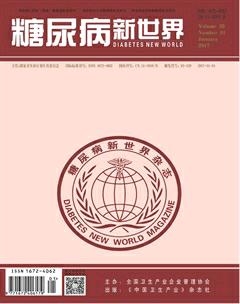急性冠脉综合征患者白介素—6与全球急性冠状动脉事件注册评分的相关性
李晶玮+王鸿+徐秀英+杜凤和+田俊萍



[摘要] 目的 探讨急性冠脉综合征(ACS)患者白介素-6(IL-6)与全球急性冠状动脉事件注册(Grace)评分之间的关系。 方法 入选2015年6月~2016年8月首都医科大学附属北京天坛医院心脏重症监护病房(CCU)首次诊断的ACS患者104例,根据Grace评分,将患者分为低危组(Grace评分≤108分)、中危组(Grace评分109~140分)和高危组(Grace评分>140分)。检测IL-6,将IL-6水平从低到高按四分位数分成Q1~Q4组。分析IL-6与Grace评分的相关性。 结果 Grace评分高危组患者IL-6高于中危组(P < 0.01)和低危组(P < 0.01)。Q4组Grace分值及高危百分比都高于Q4以下组(P < 0.05)。相关分析显示,IL-6与Grace评分呈正相关(r=0.269,P < 0.05)。 结论 ACS患者IL-6与Grace评分明显正相关,IL-6可能成为ACS患者预后判断的重要血清标志物。
[关键词] 急性冠脉综合征;白介素-6;全球急性冠状动脉事件注册;冠状动脉造影
[中图分类号] R541.4 [文献标识码] A [文章编号] 1673-7210(2017)03(b)-0076-04
Relationship between interleukin-6 and Global Registry of Acute Coronary Events score in patients with acute coronary syndrome
LI Jingwei1 WANG Hong2 XU Xiuying1 DU Fenghe1 TIAN Junping1
1.Department of Cardiology, Beijing Tiantan Hospital, Capital Medical University, Beijing 100050, China; 2.Department of Endocrinology, Aerospace Center Hospital, Beijing 100049, China
[Abstract] Objective To investigate the relationship between serum interleukin-6 (IL-6) level and Global Registry of Acute Coronary Events (Grace) score in patients with acute coronary syndrome (ACS). Methods The 104 ACS patients who came from Coronary Care Unit in Beijing Tiantan Hospital, Capital Medical University from June 2015 to August 2016 were enrolled in the present study. Serum IL-6 was measured. All the patients were divided into three groups according to Grace risk score: low risk group (≤108 score), moderate risk group (109-140 score) and high risk group (>140 score). According to the IL-6 level, patients were stratified into 4 groups by quartile (from the lowest to the highest, Q1-Q4). The relationship between serum IL-6 1evel and Grace risk scores in ACS patients was analyzed. Results The IL-6 level was significantly higher in high risk group than that in low risk group (P < 0.01) and moderate risk group (P < 0.01). As compared with Q1-Q3 group, the Grace risk score and percentage of high risk patients were higher in the Q4 group (P < 0.05). Correlation analysis found that IL-6 was positively associated with Grace risk score (r=0.269, P < 0.05). Conclusion The IL-6 is positively associated with Grace risk score in ACS patients, and IL-6 maybe an important biomarker for prognosis prediction of ACS patients.
[Key words] Acute coronary syndrome; Interleukin-6; Global Registry of Acute Coronary Events; Coronary angiography
對急性冠脉综合征(acute coronary syndrome,ACS)进行早期风险评估对患者的治疗及预后改善有重要价值[1]。全球急性冠状动脉事件注册(global registry of acute coronary events,Grace)评分是最有效的预测ACS患者病情危险程度及预后的评分体系[2]。白介素-6(interleukin-6,IL-6)为一种多功能细胞因子,不仅可预测健康人群心肌梗死的危险度,还与冠心病的严重程度、斑块的不稳定性以及预后存在一定的关系[3]。IL-6水平与冠状动脉病变Gensini评分呈正相关[4],与冠心病介入术后再狭窄的发生有相关性[5-6]。ACS患者IL-6水平升高且与病情严重程度和心脏事件发生有密切关系[7]。本研究主要观察ACS患者的IL-6水平,并探讨其与Grace评分的相关性。
1 资料与方法
1.1 一般资料
收集2015年6月~2016年8月首都医科大学附属北京天坛医院(以下简称“我院”)心脏重症监护病房(coronary care unit,CCU)收治、首次诊断的ACS患者104例,其中,男69例(66.3%),女35例(33.7%);年龄33~89岁,平均(62.38±12.12)岁。入选标准:①首次诊断的ACS患者,经冠状动脉造影证实;②获得知情同意。排除标准:并发脑卒中、周围血管疾病或周围血管栓塞性疾病者,急性感染、慢性感染急性发作者,自身免疫病、严重肝肾疾病、肿瘤、血液系统疾病、全身大动脉疾病、恶性肿瘤者,既往明确诊断冠心病者,瓣膜病变、先天性心脏病、心肌病者。本研究已获得我院伦理委员会审批批准。
1.2 方法
1.2.1 主要仪器、设备与试剂 IL-6检测使用德国西门子IMMUNITE1000化学发光免疫分析仪。IL-6检测配套试剂(LK6P1:0234,德国西门子)。生化指标测定采用日本日立LABOSPECT008型全自动生化分析仪。飞利浦800毫安以上数字减影血管造影X线机。
1.2.2 血液标本采集与处理 入院后第2天清晨8∶00之前空腹采血,抽取5 mL外周静脉血,以3000 r/min超速离心10 min后分离血清,存于-80℃低温冰箱备用。血清IL-6采用化学发光法测定(德国西门子试剂盒)。同步抽血测各项生化指标、C反应蛋白(C reactive protein,CRP)等。
1.2.3 冠状动脉造影结果分析 患者入院后介入医师完成冠状动脉造影检查,采用Judkings法。冠状动脉造影显示至少1支冠状动脉狭窄程度≥50%为冠心病诊断标准。
1.2.4 风险评分方法 用Grace评分[2]方法对入选的ACS患者进行风险评估。根據Grace评分并分为三组:≤108分为低危组,109~140分为中危组,>140分为高危组。
1.3 统计学方法
采用SPSS 17.0统计学软件进行数据分析,计量资料数据用均数±标准差(x±s)表示,多组间比较采用单因素方差分析,若方差齐,两两比较采用SNK法;若方差不齐,两两比较采用Tamhane's T2检验。计数资料用率表示,组间比较采用χ2检验。相关性分析采用Spearman直线相关分析。以P < 0.05为差异有统计学意义。
2 结果
2.1 不同Grace危险分层患者临床参数比较
高危组患者年龄、肌酐、IL-6水平明显高于中危组和低危组(P < 0.05),高危组患者的CRP高于低危组(P < 0.05),中危组患者年龄高于低危组(P < 0.01),高危组舒张压和三酰甘油低于低危组(P < 0.01),中危组患者三酰甘油亦低于低危组(P < 0.01)。三组收缩压、低密度脂蛋白胆固醇等指标比较,差异无统计学意义(P > 0.05)。见表1。
2.2 ACS患者血清IL-6水平四分位数分组与Grace评分高危组的关系
将ACS患者按照IL-6水平从低到高进行四分位数分组(Q1~Q4组)。Q1~Q3组合并统称为Q4以下组。Q1组(n=37)Grace评分为(118.38±29.34)分,Q2组(n=23)为(121.61±28.74)分,Q3组(n=23)为(120.22±27.32)分,Q4组(n=21)为(146.52±27.48)分。Q4组的Grace评分显著高于Q1、Q2和Q3组(P < 0.01)。
Q4组Grace高危百分比明显高于Q4以下组,差异有统计学意义(P < 0.05)。见表2。
2.3 ACS患者血清IL-6与Grace评分的相关性分析
相关性分析显示,IL-6与Grace评分、CK-MB、CRP呈明显正相关关系(均P < 0.05)。见表3。
3 讨论
ACS是一组急性血管综合征,主要致病机制是不稳定性斑块的纤维帽破裂和内膜的浅表糜烂[8]。炎性反应在易损斑块的形成中发挥着关键作用,并可导致不稳定斑块破裂[9-10]。Grace评分在确定冠状动脉疾病严重性以及预测非ST段抬高心肌梗死出院6个月内死亡具有重要价值[11]。Grace评分在预测临床指标优于TIMI评分及PURSUIT评分[12]。
IL-6是一种重要的炎症介质,其表达水平与组织的炎性反应程度呈正相关,也能激活CRP的表达增多[13]。冠脉病变Gensini评分与血清中IL-6水平呈正相关[4]。本文发现,随着患者IL-6的增大,Grace评分增高,ACS患者IL-6与Grace评分呈正相关。IL-6与CRP也呈正相关,与上述结果一致。研究显示,IL-6水平与缺血和心力衰竭终点独立相关,可以提高GRACE评分预测性能[14],与本研究相符。对于肌钙蛋白阴性、低中度风险的非ST段抬高的ACS患者,IL-6是一个独立预测不良事件的因子,它的使用可以识别中度风险患者中的高风险人群[15]。IL-6-572 G>C(rs1 800796)多态性可能参与ACS发生的危险[16]。IL-6对非ST段抬高急性冠状动脉综合征患者的预后危险分层有意义[17]。国内研究显示,血清IL-6和肿瘤坏死因子相关蛋白-1浓度的变化可反映炎症程度以及冠状动脉病变严重程度[18]。血清IL-6水平和CRP可用于判断斑块的稳定性,在ACS的预后判断具有价值[19]。IL-6和IL-33可作为评价ACS或稳定型心绞痛患者冠心病炎性反应和严重程度的生物标志物[20]。
本研究显示,Grace评分高危组患者的IL-6水平与中危组和低危组差异均有统计学意义(均P < 0.01);中危组的IL-6水平在数值上高于低危组,但两组之间差异无统计学意义(P > 0.05)。提示IL-6与ACS的病情严重程度可能存在相关。进一步将ACS患者按照IL-6水平从低到高进行四分位数分组,Q4组Grace分值及高危百分比均高于Q4以下组,表明IL-6水平与ACS患者的病情危险程度密切相关。相关分析显示,IL-6与Grace评分、CK-MB、CRP均呈正相关关系(P < 0.05)。提示IL-6水平可作为ACS危险程度的监测指标,对ACS患者进行更科学、更准确的早期风险评估,是可对临床现有危险分层方法进行的必要补充。
綜上所述,IL-6的监测对预防ACS的发生及预后评估具有重要的参考价值。本研究提示ACS患者IL-6与Grace评分具有相关性,IL-6可以弥补Grace评分及其他风险评估方法未纳入反映机体神经体液因素及血流动力学变化的不足。本研究是观察性研究,样本量偏少,观察时间偏短,需在多中心、大规模人群中进行更全面研究分析。
[参考文献]
[1] Raposeiras-Roubín S,Abu-Assi E,Cabanas-Grandío P,et al. Walking beyond the GRACE model in the death risk stratification during hospitalization in patients with acutecoronary syndrome:what do the AR-G Registry and GWTG,NCDR,and EuroHeart Risk Scores Provide?[J]. JACC Cardiovasc Interv,2012,5(11):1117-1125.
[2] Widera C,Pencina MJ,Meisuer A,et al. Adjustment of the GRACE score by growth differentiation factor 15 enables a more accurate appreciation of risk in non-ST-elevation acute coronary syndrome [J]. Eur Heart J,2012,33(9):1095-1104.
[3] Vgontzas AN,Bixler EO,Lin HM,et al. IL-6 and its circadian secretion in humans [J]. Neuroimmunomodulation,2005,12(3):131-140.
[4] De Gennaro L,Brunetti ND,Montrone D,et al. Subacute Inflammatory Activation in Subjects with Acute Coronary Syndrome and Left Ventricular Dysfunction [J]. Inflammation,2012,35(1):363-370.
[5] Blanco-Colio LM,Martín-Ventura JL,de Teresa E,et al. Atorvastatin decreases elevated soluble CD40L in subjects at high cardiovascular risk. Atorvastatin on inflammatory markers study:a substudy of ACTFAST [J]. Kidney Int Suppl,2008,74(111):S60-63.
[6] Lowe GD. Local inflammation,endothelial dysfunction and fibrinolysis in coronary heart disease [J]. Clin Sci(Lond),2006,110(3):327-328.
[7] Antman EM,Anbe DT,Armstrong PW,et al. ACC/AHA guidelines for the management of patients with ST-elevation myocardial infarction-executive summary: a report of the American college of cardiology/American heart association task force on practice guidelines [J]. Circulation,2004,110(5):588-636.
[8] Libby P. Mechanisms of acute coronary syndromes and their implications for therapy [J]. N Engl J Med,2013,368(21):2004-2013.
[9] Bentzon JF,Otsuka F,Virmani R,et al. Mechanisms of plaque formation and rupture [J]. Circ Res,2014,114(12):1852-1866.
[10] Liang Y,Hou Y,Niu H,et al. Correlation of high-sensitivity C-reactive protein and carotid plaques with coronary artery disease in elderly patients [J]. Exp Ther Med,2015,10(1):275-278.
[11] Martins A,Ribeiro S,Goncalves P,et al. Role of central obesity in risk stratification after an acute coronary event:does central obesity add prognostic value to the Global Registry of Acute Coronary Events(GRACE)risk score in patients with acute coronary syndrome?[J]. Rev Port Cardiol,2013,32(10):769-776.
[12] Cakar MA,Sahinkus S,Aydin E,et al. Relation between the GRACE score and severity of atherosclerosis in acute coronary syndrome [J]. J Cardiol,2014,63(1):24-28.
[13] Yue Y,Liu R,Lu J,et al. Reliability and validity of a mew post-stroke depression scale in Chinese population [J]. Jour nal of Affective Disorders,2015,174:317-323.
[14] Beygui F,Silvain J,Pena A,et al. Usefulness of biomarker strategy to improve GRACE score's prediction performance in patients with non-ST-segment elevation acute coronary syndrome and low event rates [J]. Am J Cardiol,2010, 106(5):650-658.
[15] García-Salas JM,Tello-Montoliu A,Manzano-Fernández S,et al. Interleukin-6 as a predictor of cardiovascular events in troponin-negative non-ST elevation acute coronary syndrome patients [J]. Int J Clin Pract,2014,68(3):294-303.
[16] Fragoso JM,Delgadillo H,Juárez-Cedillo T,et al. The interleukin 6 -572 G>;C(rs1800796)polymorphism is associated with the risk of developing acute coronary syndrome [J]. Genet Test Mol Biomarkers,2010,14(6):759-763.
[17] López-Cuenca A,Manzano-Fernández S,Lip GY,et al. Interleukin-6 and high-sensitivity C-reactive protein for the prediction of outcomes in non-ST-segment elevation acute coronary syndromes [J]. Rev Esp Cardiol(Engl Ed),2013,66(3):185-192.
[18] Tang JN,Shen DL,Liu CL,et al. Plasma levels of C1q/TNF-related protein 1 and interleukin 6 in patients with acute coronary syndrome or stable angina pectoris [J]. Am J Med Sci,2015,349(2):130-136.
[19] Wang XH,Liu SQ,Wang YL,et al. Correlation of serum high-sensitivity C-reactive protein and interleukin-6 in patients with acute coronary syndrome [J]. Genet Mol Res,2014,13(2):4260-4266.
[20] Liu CL,Shen DL,Zhu K,et al. Levels of interleukin-33 and interleukin-6 in patients with acute coronary syndrome or stable angina [J]. Clin Invest Med,2013,36(4):E234-241.

